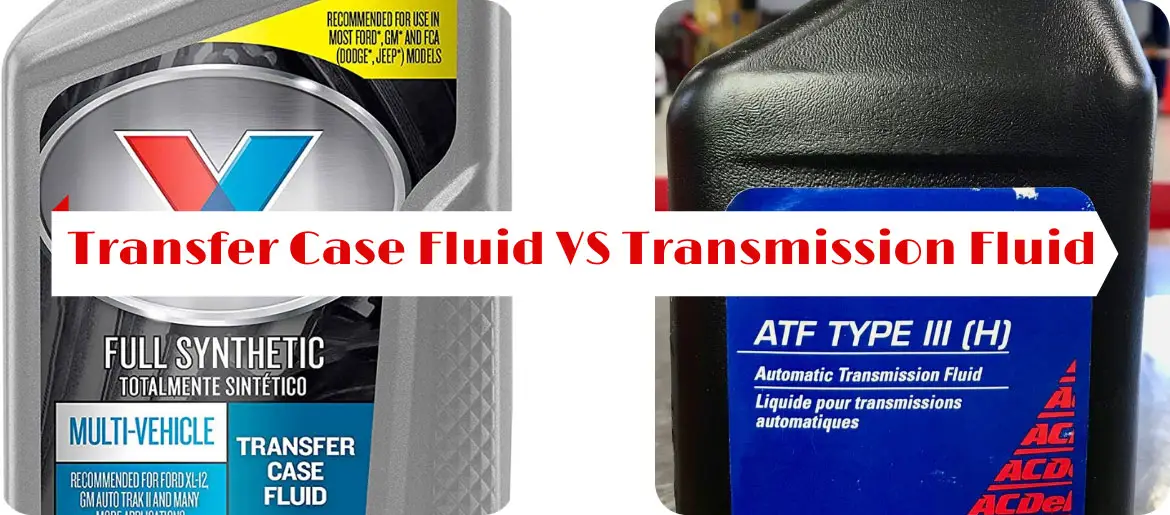Transfer Case Fluid VS Transmission Fluid
The main difference between transfer case fluid and transmission fluid is their function and application.
Transfer case fluid lubricates the transfer case, a component in four-wheel-drive (4WD) and all-wheel-drive (AWD) vehicles, enabling the distribution of power to the front and rear axles. It ensures proper operation and prevents overheating.
Transmission fluid, on the other hand, lubricates the internal components of the transmission, facilitates smooth shifting, and helps with cooling. It is essential for automatic and manual transmissions.

So, read on to know every aspect that distinguishes transfer case fluid from the transmission fluid.
What Is Transfer Case Fluid?
One common question from new car owners is what kind of fluid goes in a transfer case. Well, the fluid that’s stored in the transfer case reservoir is known as transfer case fluid. This is a highly viscous and lubricating liquid.
This liquid also has cooling properties. It lubricates the gears and keeps them cool. As a result, the gears can shift smoothly without facing premature wear.
In some vehicles, transfer case oil also lubricates the wet clutch which decides how much power the front and back wheels will receive. This liquid is thicker in consistency and contains sulfur compounds as a lubricating agent.
In newer vehicles, specialized transfer case fluids are used. But in older models, gear oil is used for this purpose.
What Is Transmission Fluid?
Transmission fluid has diverse operations based on the transmission system. Its primary function is lubricating the transmission. All the delicate parts inside the transmission stay submerged in this oil.
This thin lubricating fluid transfers power from engine to transmission. It’s a hydrocarbon liquid that can also prevent debris build-up utilizing its detergent components. Moreover, gears receive proper friction and pressure from it.
Besides these, transmission liquid also acts as a coolant in manual and automatic systems. Its heat-resistant feature keeps the temperature inside the transmission under control. So, the engine runs without wearing out.
Transfer Case Fluid & Transmission Fluid Differences
The main difference between transfer case fluid and transmission fluid is that the transfer case fluid is a highly viscous liquid that lubricates the gears, helps to shift smoothly and keeps them cool. On the other hand, transmission fluid lubricates the transmission system to run the transmission smoothly.
However, keep scrolling to know a detailed comparison of these two fluids.
1. Color & Composition
Transfer case oil and transmission oil vary in color and composition.
1.1. Transfer Case Fluid:
Transfer case fluid can be made of hydrocarbon or polyglycerols. When gear oil is used inside the transfer case, the transfer case fluid color will generally be green, blue, yellow, or brown. But if the transmission fluid is used, the oil will be clear with a dark reddish hue.
1.2. Transmission Fluid:
There are two types of transmission systems: manual transmission and automatic transmission. That’s why fluids are classified into two groups: Automatic Transmission Fluid (ATF) and Manual Transmission Fluid (MTF).
MTF can be regular motor oil, synthetic fluid, or ATF. ATF’s are a complex formulation of various additives along with a petroleum or hydrocarbon base fluid.
Transmission oils come in shades of red when new. They turn brown or black when contaminated.
2. Area Of Operation
The main difference between the transfer case and transmission oil lies in their area of operation. One operates in the transfer case and the other inside the transmission system.
2.1. Transfer Case Fluid:
The transfer case is the system that splits the power among the front and rear wheels in four-wheel or all-wheel vehicles. This system basically takes the power generated by the transmission system and divides it between the front and back wheels.
Transfer case liquid operates inside this system. This system is located on the rear of the transmission. The fluid keeps the internal parts lubricated and prevents damage. If the fluid is contaminated or old, it can cause severe damage to the transfer case.
2.2. Transmission Fluid:
Transmission fluid is stored inside the transmission of a vehicle. The transmission system is the gearbox that transfers power from the engine to the rear wheels and controls speed using gears. It is located partially underneath the engine on the front part of the car.
Here, multiple gears shift automatically with engine demand. Shifting gears is a highly laborious chore for the engine. Transmission fluid lubricates the gears and allows them to shift smoothly without wear.
When this liquid gets low, the transmission components wear out significantly faster. If you don’t solve this issue, you can end up facing complete transmission failure.
3. Replacement
Changing the liquids at the recommended interval is necessary for ensuring their proper workflow. Both transfer case and transmission liquid require replacement at different intervals.

3.1. Transfer Case Fluid:
Transfer case fluid can get soiled with time and use. Dirty liquid cannot properly lubricate the system. So, regular maintenance is crucial for keeping the system working.
How often you need to replace the transfer case fluid depends on several factors. The first one is the make and model of your vehicle. So, go through your owner’s manual to find out the advised mileage for the change of transfer fluid.
Typically, you should check it after 20,000 to 30,000 miles. But if you frequently take your vehicle off-roading, you have to get this fluid checked more often. Moreover, cars that are used for towing also need more regular transfer liquid change.
3.2. Transmission Fluid:
In manual transmission systems, the metal inside the gearbox wears out and contaminates the fluid. Polluted oil loses its lubricating power and the overall performance decreases.
To avoid this, you need to check the transmission liquid every 30,000 to 60,000 miles in manual systems. If the fluid is soiled, drain it and refill with new fluid.
Automatic transmission oil has a lengthier lifespan than transfer case fluid. ATF can even last the lifetime of a car
However, extreme heat and metal degradation can cause contamination in this fluid too. So, it’s wise to inspect the liquid level every 30,000 to 100,000 miles.
FAQ
What Happens If the Transfer Case Is Low On Fluid?
Low fluid won’t be able to lubricate the transfer case components properly. Hence, the gears will face tremendous wear and damage. This will cause the transfer case to overheat. As a result, the 4W drive operation will fail.
Can I Drive With A Damaged Transfer Case?
You can drive with a damaged transfer case but you really shouldn’t. Driving with a broken transfer case will damage it beyond repair. Moreover, your transmission, axles, and even the entire drivetrain can get damaged doing so.
What Are the Symptoms Of Low Transmission Fluid?
A few common symptoms of low transmission fluid are: grinding or whining noise, leaking fluid, burning smell, and slipping gears.
How To Check For Transfer Case Oil Leak?
First, drain the dirty transfer case fluid. Fill the case with new liquid. Then, take your vehicle on a test drive to see if any fluid is still leaking.
How To Change The Transfer Case Liquid?
Changing the transfer case liquid is a fairly simple task. You only need to drain the old fluid by taking out the threaded plug. Then, pull out the fill plug and fill the case with new fluid.
Wrapping It Up
Transfer case and transmission fluid vary in many aspects. While the former facilitates the transfer case functions, the latter keeps the transmission system functional.
Both of these fluids are crucial for keeping your car in good shape. Hence, knowing the differences between transfer case fluid vs transmission fluid is a must for every car owner. Hopefully, our discussion has cleared any doubts you had regarding these fluids. Lastly, always get the fluid levels checked after the required period to keep your car in its best shape.



